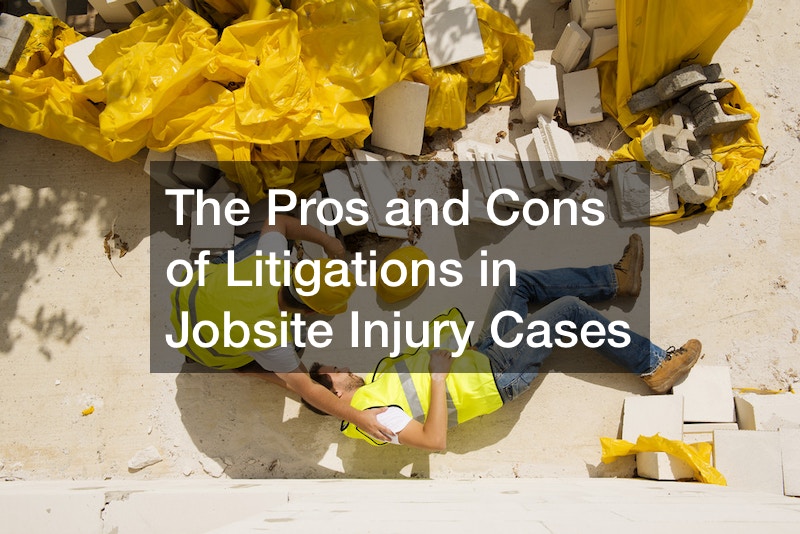Workers’ compensation usually covers jobsite injuries. However, according to the Industrial Safety & Hygiene News, there are situations where you can bring a civil suit against your employer or other negligent party. For example, you can sue an employer who intentionally caused an accident, doesn’t have a worker comp cover, or another third party who caused your injuries. However, before you decide on this option, you should know that there are several pros and cons of litigations. Below is a look at some of them:
Pro: Lasting, High-Quality Resolutions
One of the top pros and cons of litigations in jobsite injury cases is the high-quality and lasting resolutions offered. For one, with litigation, there’s always a clear outcome. Secondly, decisions in litigation cases are a matter of public record and binding, even if one or both parties disagree.
Take, for example, the case of a contractor suing a local roofing service for injuries sustained during a roofing installation job. If the contractor takes the case to court, the judge or the jury can decide either in favor of the contractor or the roofing business. According to Enjuris, some jurisdictions’ personal injury laws have a shared or contributory fault clause. Therefore, the court could share the blame between the contractor and the roofing business or assign blame to other third parties.
Whichever way the court decides in a litigation case, the decision must be accepted by both the defendant and the plaintiff. The fact that an unbiased third party makes the decision also helps to make it easier to accept. Ultimately, opting to litigate in a jobsite injury case can be very beneficial as you’re guaranteed an outcome that will firmly put the matter to rest.
Pro: Setting a Legal Precedent
Precedent is another aspect to consider when examining the pros and cons of litigations in workplace injury cases. The U.S. legal system is mostly based on precedents. This means that previous court decisions are used in deciding future cases, and where there are none, a new case can set a precedent that will be followed for years.
According to UOLLB First Class Law Notes, legal precedents have several benefits, the top one being ensuring consistency, fairness, and predictability in court decisions. In addition, they help to improve efficiency for future cases. Therefore, choosing to litigate a jobsite injury case can be very beneficial, as it can make it easy for other people in a similar condition to receive justice.
For example, take the case of a contractor injured when working for an electrical panel service company. Apart from worker’s compensation, they could also sue other negligent parties, such as a utility company whose fault caused the accident. If the case is decided in their favor, the outcome can be used as a precedent that makes it easier for other injured contractors to sue negligent power companies.

Pro: Strong Evidence Guidelines
The evidence guidelines are another top factor to consider when considering the pros and cons of litigations. According to Justia, civil courts have strict evidentiary standards that must be followed. Consequently, after presenting admissible evidence, an individual has the burden of proof, i.e., persuading the court their assertions are true based on the evidence presented.
The use of a higher threshold of evidence in litigation cases can benefit both the complainant and the defendant. For example, take the case of an employee for a drain tile service business suing for injuries sustained during a job. If the worker has strong and substantial evidence, they can easily prove their case in court. Consequently, they can receive fair compensation for the injuries and losses suffered.
On the other hand, a business being sued for a jobsite injury can also benefit significantly from litigation’s strict evidence guidelines. That’s because the complainant has to present credible evidence proving that the business was negligent or acted intentionally in causing the damage. In addition, they can also provide evidence to counter claims that they feel are false or inaccurate.
Pro: Appeal Options
According to the U.S. Courts, appeals are vital in promoting judicial impartiality and independence. That’s because they allow aggrieved parties in a case to challenge a court decision they feel was made in error. Therefore, if you’re considering taking your workplace injury case to court, the possibility of appeals is another of the pros and cons of litigations you must consider.
The ability to appeal can benefit complainants in a court of law. For example, if a local roofer loses out on a case when suing for injuries sustained, they can appeal the decision and have a higher court review their complaint. Consequently, this gives them another chance to be heard by a different court and, possibly, receive a ruling in their favor. And they can continue appealing decisions until they receive one that favors them or exhaust all the avenues of appealing.
Likewise, a defendant in a workplace injury case can use the option of appeal to challenge a decision that has been made against them. If they are lucky, a higher court can overturn the decision, thus absolving them of the liability. Alternatively, the court may change some of the decisions, such as lowering the compensation if they feel the one offered was unjustified.

Pro: Unilateral Verdict
Unilateral decisions are another top factor when examining the pros and cons of litigations in jobsite injury. Unlike other types of alternative dispute resolution, court cases are decided unilaterally by the judge or the jury. This can offer several benefits if you decide to take your case to court.
One of the top benefits of unilateral verdicts is a guaranteed decision. This helps to make the process a success despite the outcome. As such, it might be a better option than other dispute resolution options, for example, mediation, where both parties have come to a consensus, which is sometimes impossible.
Another benefit of unilateral decisions in court cases is that they might provide a faster solution. For example, take the case of local electricians suing their employer for damages sustained at work. They might not reach an agreement if forced to go through mediation, which can further prolong their plight. However, by leaving the decision to a judge or jury, they might realize a much faster outcome for their case.
Con: No Control Over Decision Maker
When looking into the pros and cons of litigation, you’ll realize that there can be several drawbacks to taking your jobsite injury case to court. And one of the top disadvantages is that you don’t have any influence on the decision-maker. Therefore, even if they’re impartial, they can still make a binding decision against you.
The lack of control over the decision-maker can be especially detrimental when a jury decides the case. For example, take the case of a crane rental company being sued by a contractor for injuries sustained through one of their equipment. In litigation, the jury members are unlikely to be law experts nor familiar with construction industry practices and regulations. As a result, they might make a misinformed decision that can harm one of the parties.
If you’re considering taking your case to court, you might be better suited to try another alternative, such as mediation. According to NOLO, during the mediation process, the disputing parties are the ones who make the decision and not the court. Apart from mediation, settlement negotiation is another ideal way to resolve a jobsite workplace injury case, as it involves both parties reaching a favorable agreement.

Con: Documentation Requirements
The strict evidence guidelines can be both pros and cons of litigations when pursuing a claim in a jobsite injury case. While a high evidentiary threshold is vital for ensuring accurate court decisions, it’s also very restrictive as it places stringent documentation standards that might be hard to satisfy. Consequently, you might have the case decided against you, even when the facts are in your favor.
Due to the strict documentation requirements, you must collect large amounts of evidence in litigation, which can be very hectic. Take the case of an injured contractor; when filing a case, they need to obtain vast amounts of evidence from accident reports, witness statements, medical reports, medical bills, expert statements, and more. Some of the evidence might be particularly difficult to acquire, for example, if an individual has to visit several local walk in clinics to access medical reports.
So, once again, you might be better off opting for other dispute resolution methods instead of litigation. For example, solutions like mediation, negotiation, and arbitration don’t have strict evidence guidelines. This means you can present evidence you wouldn’t normally present in a court of law, which is a huge advantage.
Con: Time Requirements
Time is another factor to consider when researching the pros and cons of litigations in a workplace injury case. According to research by Syracuse University, the time it takes for a civil case to go to trial (from filing) has increased by 63% in the last 20 years. This is because of the increased workload facing the judges without a subsequent increase in court resources.
Therefore, you must be prepared for the huge time commitments required when pursuing litigation. For example, it might take several months to receive a court date. Then, you’ll need to attend several pre-hearing sessions and go through evidence discovery before your case is heard. On top of that, even when the verdict is reached, it might take several more months (or years) if the other party decides to appeal.
Time requirements of litigation can also be a huge disadvantage for an organization involved in a jobsite injury case. For example, say, own a business that offers local excavation service. Attending court hearings will mean taking away important time from your enterprise. This can severely harm your business, even if you receive a favorable outcome.

Con: Damaged Professional Relationships
The U.S. legal system is adversarial. And according to Connect US, one of the top drawbacks of such a system is that it requires opposing parties to contest their case in court. Unfortunately, this has the potential to get very ugly and damage any pre-existing relationships. Therefore, if you are researching the pros and cons of litigations, this is one of the top drawbacks you need to consider.
One of the top ways litigating a jobsite injury case can damage your relationship is when suing an employer. For example, say you work for a masonry company and were injured during the job. If you decide to file a civil case against your employer, they might take that as a personal attack. And while it’s illegal for your boss to retaliate, they might still do it in subtle ways that jeopardize your career.
Litigation can also disadvantage a business involved in a personal injury case. After all, any decision reached in court is a matter of public record, accessible to anyone. Therefore, a negative decision against an enterprise will likely ruin its reputation, affecting professional relationships with employees, clients, and other businesses.
Con: Legal Costs
Costs are another aspect to consider when deciding on the pros and cons of litigations in a jobsite injury case. Court cases are among the most expensive of the available dispute resolution methods. According to Harvard Business Review, mediation in a dispute can cost around $25,000. However, it can cost up to $700,000 when negotiating with lawyers and $2.5 million when litigating the case in court.
High lawyer fees are one of the top reasons why litigations are so expensive. After all, you must hire good (often expensive) lawyers to mount a good argument. In addition, cases often drag on for a long time, allowing the lawyer fees to pile up. Lastly, there are other associated costs, for example, court fees, investigator charges (for evidence collection), and fees to expert witnesses for testimony in court.
Unfortunately, the court fees can be a huge disadvantage for all parties involved in a case. For example, an employee suing for injuries sustained would have to dig deep to afford the legal costs or forfeit part of the settlement money received. Likewise, legal costs can be detrimental to an organization, for example, a hardscaping services business that has to divert some of its financial resources to protect its interest in a court case.
A court case can be a good method of resolving disputes in jobsite injury cases. However, there are several pros and cons of litigations that you should consider before pursuing this option. After all, on the one hand, going to court can offer you several advantages that can increase your chances of a favorable decision. And on the other hand, you can encounter several challenges that can affect your pursuit of justice.




